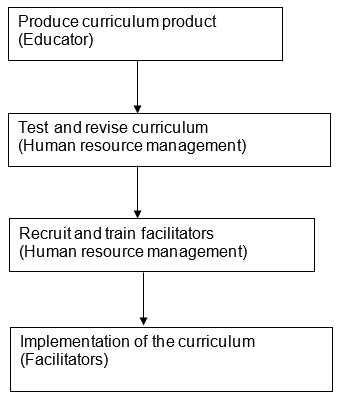Implementation can be understood in two ways. The first one is to understand how an organization has changed its structures as well as the type of changes. This involves understanding how ideas are flowing to fit the real world situation (Ornstein & Hunkins, 2009). The other one is to understand the relationship between the social institution context and the curricula. It is under this relationship that both an institution and its curriculum are related.
Educators need to understand the nature of the institution, how it is run, power relationships, its members and its traditions among other aspects, which need to be put into consideration (Ornstein & Hunkins, 2009). These institutional characteristics apply in businesses and schools. To know whether the implementation process is successful or not, the participants must appreciate the installed curriculum.
The curriculum implementation process starts with the stakeholders identifying the issue or problem at hand. This is followed by checking out on the targeted population, as well as its characteristics and needs. Next is figuring out how the anticipated changes will be instilled by the learners. This is what is expected after the implementation of the curriculum. The methods of usage to get the intended outcomes should be figured out. The final step is to evaluate the method strategies, the content, as well as the expected outcomes of the curriculum (Ornstein & Hunkins, 2009).
Research has shown that most curricula end up not being implemented into school programs because of lack of comprehensive plans of incorporating them into the systems (Ornstein & Hunkins, 2009). This arises because there are no enough educators with managerial skills and knowledge to deliver the new curricula into school programs.
Implementation process
Implementation phase has four major steps, which include: production of curriculum product, testing and revising the curriculum, recruiting and training the facilitators, and implementing the final curriculum. The implementation phase is illustrated in the four steps of the flow chart below.

The process of implementation, illustrated above, will take place as explained below
Produce curriculum product
After all stakeholders have agreed upon the content and experimental methods, the actual production of the curriculum materials will begin (Baron, Boschee & Jacobson, 2008). At this point, the educator will suggest ways of finding and evaluating available materials. He or she will also evaluate the criteria to be used and give suggestions on how to produce curriculum materials.
Testing and revision of curriculum
First of all, an educator should suggest all the possible selection sites. The educator will conduct formative stage evaluation of the materials to be used in the production phase (Baron, Boschee & Jacobson, 2008).
Recruitment and training of facilitators
The organization has to get all possible materials and time to train the facilitators. If facilitators will not be trained effectively, they will implement the curriculum inadequately. This will lead to a waste of time and resources. Therefore, this is a critical step, which should be given enough emphasis.
Implementation of the curriculum
With proper planning of the newly developed curriculum products, the implementation will be easy (Baron, Boschee & Jacobson, 2008). Therefore, it is necessary to strictly follow all the required phases; beginning with planning, content, and method before getting to the implementation phase.
Implementation Strategies
There are two general approaches to curriculum implementation strategies. The first approach is the program approach (fidelity approach). This approach aims at solving the implementation problem by relying on the flaws in the product specification (Canadian Ministry of Education, 1992). The other one is the adaptive-evolutionary approach, which agrees that innovation will undergo modifications during the implementation process. Mutual adaptation is another important and effective primary feature of curriculum implementation (Canadian Ministry of Education, 1992). Mutual adaptation allows the project to be adapted in its institutional and contextual patterns to meet the demands of the project.
Quality curriculum implementation calls for research and regular evaluations. It also requires the educator, under the participation of the practitioner, to develop during the implementation process. Curriculum implementation must comply with certain conditions. These are for example, the participators’ experiences during the process (Canadian Ministry of Education, 1992). The process requires concrete interaction between the educators and learners. This ensures that high learning potential opportunities are developed.
In the programmed approach, care is taken for the sake of communicating the intentions of the program and means of implementing the program. This makes the evaluation of the program clear and straightforward (Canadian Ministry of Education, 1992). The program is limited by the fact that only programmable innovations are accepted. So the approach is not the best there is (Canadian Ministry of Education, 1992). Second, personal characteristics and organizational characteristics vary from one region to the other. As a result, the approach may delay when implementation problems come up.
Conclusion
There is need to increase knowledge in the usage context of research and curriculum implementation. People should be selected from complex multidimensional professional backgrounds to solve problems of implementation. The implementation process is complex, and this has made success prediction impossible. However, this creates an opportunity for the curriculum makers to actively participate in the elusive exercise of supporting implementation so as to achieve its goal (Ornstein & Hunkins, 2009). This is also advantageous to the section of monitoring implementation. To ensure periodical application of remedies toward the coping of unexpected difficulties, implementation must be done carefully at every stage of the process.
References
Baron, M.A., Boschee, F., & Jacobson, M. (2008). Performance-based education: Developing programs through strategic planning. Lanham, MD: Rowman & Littlefield Education.
Canadian Ministry of Education. (1992). Language arts English primary–graduation curriculum guide. Victoria, BC: Author.
Ornstein, A.C., & Hunkins, F.P. (2009). Curriculum: Foundations, principles, and issues. Boston, MA: Allyn & Bacon.